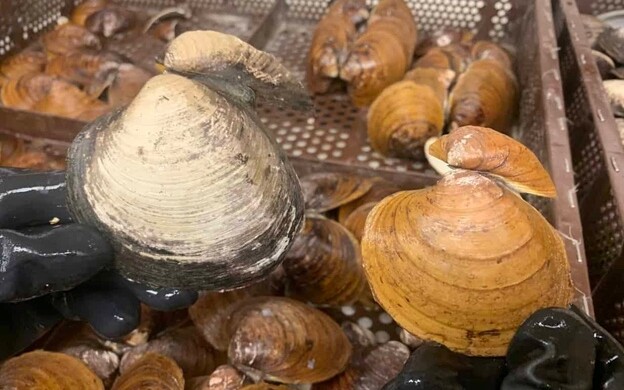Ocean quahogs are growing much faster and maturing earlier, in “one of the clearest examples of how climate change is affecting marine life,” according to the Science Center for Marine Fisheries.
Two new studies funded by the center found “a clear pattern of biological change over time in response to climate conditions” during the past two centuries, according to a summary. Ocean quahogs can live 200 years – one of the longest-lived marine species.
“In 1800, the average ocean quahog reached full maturity between 18 and 26 years, and reached a commercially harvestable size (according to the standards of the modern fishery, developed in the 20th century) in anywhere from 63 to 119 years,” according to the center. “By 2000, ocean quahogs were reaching maturity as early as 8 years, and had reached harvestable size between 26 and 29 years, over three times faster than 200 years ago.”
The papers, published in the journals Continental Shelf Research and Estuarine, Coastal, and Shelf Science, examined ocean quahog growth rates, and their changes over time, by studying the age and length data of a large, diverse sample set of ocean quahogs, and finds a clear pattern of biological change over time in response to climate conditions.
Researchers examined nearly 1,500 ocean quahogs collected by commercial clamming vessels F/V Big Bob and F/V John N, homeported in New Jersey, when they were fishing in 2019 on two sample sites off New Jersey, one on Georges Bank and one off Long Island.
The sharp change in growth and maturity rates correspond directly with long-term rising temperatures at the sample sites.
“This is a clear demonstration of the dramatic change in ocean climate over the last 200 years, and how one species has adapted with it over time,” said Jillian Sower, of the Gulf Coast Research Laboratory at the University of Southern Mississippi, and a lead author of one of the studies. “Studying ocean quahogs gives us the history of both this species and the ocean around it, and these studies are a significant addition to that historical record.”
“We are in a unique position to draw from one of the most extensive samples of ocean quahog available anywhere,” said Kathleen Hemeon, of the Gulf Coast Research Laboratory, and a lead author of another one of the studies. “We have an unusually clear picture of ocean quahogs both over time and across regions, and can be confident that the results of these studies reflect an accurate picture of the ocean quahogs over the last 200 years.”
Quahogs “from south of the Hudson Canyon have higher growth rates at older ages compared to the other three sites,” the researchers noted. “Growth rates have been increasing over the past three centuries, potentially due to increasing bottom water temperatures, with time to maturity and time to commercial size drastically decreasing, leading to fewer years for reproduction prior to recruiting into the fishery.”
The Science Center for Marine Fisheries brings university researchers and fisheries groups together to work on scientific problems limiting sustainable fisheries. The group’s university partners include the University of Southern Mississippi as lead institution, with the Virginia Institute of Marine Science and College of William and Mary as academic sites.
Collaborating scientists with expertise in finfish, shellfish, and marine mammal research come from a range of institutions includingn Old Dominion University, Rutgers University, University of Massachusetts-Dartmouth, University of Maryland, and University of Rhode Island.







